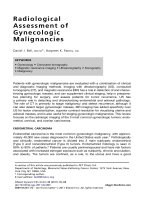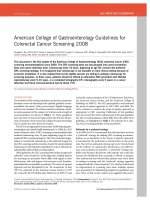American MiniHandbook of Hematologic Malignancies
Bạn đang xem bản rút gọn của tài liệu. Xem và tải ngay bản đầy đủ của tài liệu tại đây (1000.43 KB, 154 trang )
Oxford American
Mini-Handbook
of Hematologic
Malignancies
This material is not intended to be, and should not be considered,
a substitute for medical or other professional advice. Treatment for
the conditions described in this material is highly dependent on the
individual circumstances. While this material is designed to offer accurate information with respect to the subject matter covered and to be
current as of the time it was written, research and knowledge about
medical and health issues are constantly evolving, and dose schedules
for medications are being revised continually, with new side effects
recognized and accounted for regularly. Readers must therefore
always check the product information and clinical procedures with the
most up-to-date published product information and data sheets provided by the manufacturers and the most recent codes of conduct and
safety regulation. Oxford University Press and the authors make no
representations or warranties to readers, express or implied, as to the
accuracy or completeness of this material, including without limitation
that they make no representations or warranties as to the accuracy or
efficacy of the drug dosages mentioned in the material. The authors
and the publishers do not accept, and expressly disclaim, any responsibility for any liability, loss, or risk that may be claimed or incurred as
a consequence of the use and/or application of any of the contents of
this material.
The Publisher is responsible for author selection and the Publisher and
the Author(s) make all editorial decisions, including decisions regarding
content. The Publisher and the Author(s) are not responsible for any
product information added to this publication by companies purchasing
copies of it for distribution to clinicians.
Oxford American
Mini-Handbook
of Hematologic
Malignancies
Gary H. Lyman, MD, MPH,
FRCP (Edin)
Professor of Medicine and Senior Fellow
Duke Center for Clinical Health Policy Research
Duke University
Durham, North Carolina
with
Jim Cassidy
Donald Bissett
Roy A.J. Spence
Miranda Payne
1
1
Oxford University Press, Inc., publishes works that further
Oxford University’s objective of excellence
in research, scholarship, and education.
Oxford New York
Auckland Cape Town Dar es Salaam Hong Kong Karachi
Kuala Lumpur Madrid Melbourne Mexico City Nairobi
New Delhi Shanghai Taipei Toronto
With offices in
Argentina Austria Brazil Chile Czech Republic France Greece
Guatemala Hungary Italy Japan Poland Portugal Singapore
South Korea Switzerland Thailand Turkey Ukraine Vietnam
Copyright © 2010 by Oxford University Press, Inc.
Published by Oxford University Press, Inc.
198 Madison Avenue, New York, New York 10016
www.oup.com
Oxford is a registered trademark of Oxford University Press
All rights reserved. No part of this publication may be reproduced,
stored in a retrieval system, or transmitted, in any form or by any means,
electronic, mechanical, photocopying, recording, or otherwise,
without the prior permission of Oxford University Press.
The Library of Congress has cataloged the Oxford American Handbook
of Oncology, 1st edition as follows:
Oxford American handbook of oncology / edited by Gary H. Lyman.
p. ; cm. — (Oxford American handbooks)
Adapted from: Oxford handbook of oncology. 2nd ed. 2006.
Includes bibliographical references and index.
ISBN 978-0-19-536061-2 (flexicover : alk. paper)
1. Cancer—Handbooks, manuals, etc. 2. Oncology—Handbooks, manuals, etc.
I. Lyman, Gary H., M.D. II. Oxford handbook of oncology. III. Title: Handbook
of oncology. IV. Series.
[DNLM: 1. Neoplasms–Handbooks. QZ 39 O9 75 2009]
RC262.5.O944 2009
616.99´4–dc22 2008034278
9 8 7 6 5 4 3 2 1
Printed in United States of America
on acid-free paper
Disclosures
v
Dr. Lyman has been on the Speakers’ Bureau as well a grants/
research support recipient at Amgen. He has also been on the
Speaker’s Bureau at Ortho Biotech.
This page intentionally left blank
Contents
Contributors ix
Part I Introduction
1 Molecular cancer pathology
2 Molecular alterations in cancer
3 Cancer biology
3
5
11
Part II The hematological malignancies
4 Acute myeloid leukemia (AML)
5 Acute lymphoblastic leukemia (ALL)
6
7
8
9
Part III Chronic leukemias and
myelodysplastic syndromes
Chronic myeloid leukemia (CML)
Myelodysplastic syndromes (MDS)
Chronic lymphoid leukemias
Multiple myeloma
21
29
37
43
49
59
Part IV Malignant lymphoma
10
11
12
13
Hodgkin lymphoma (HL)
Non-Hodgkin lymphomas (NHL)
Management strategies for NHL
Non-Hodgkin lymphoma and acquired
immunodeficiency disorder
Part V Treatment and management
for hematological malignancies
14 Hematopoietic stem cell transplantation
15 Targeted therapies
Index 137
75
83
93
99
105
117
This page intentionally left blank
Contributors
Anne W. Beaven, MD
Division of Medical Oncology, Department of Medicine
Duke University Medical Center
Durham, North Carolina
Division of Medical Oncology, Department of Medicine
Duke University Medical Center
Durham, North Carolina
Carlos M. DeCastro, MD
Division of Medical Oncology, Department of Medicine
Duke University Medical Center
Durham, North Carolina
Louis F. Diehl, MD
Division of Medical Oncology, Department of Medicine
Duke University Medical Center
Durham, North Carolina
Phuong L. Doan, MD
Department of Medicine
Duke University Medical Center
Durham, North Carolina
Phillip Febbo, MD
Division of Medical Oncology, Department of Medicine
Duke University Medical Center
Durham, North Carolina
Daphne Friedman, MD
Division of Medical Oncology, Department of Medicine
Duke University Medical Center
Durham, North Carolina
ix
Gerard C. Blobe, MD, PhD
CONTRIBUTORS
Cristina Gasparetto, MD
Division of Cellular Therapy, Department of Medicine
Duke University Medical Center
Durham, North Carolina
Jon Gockerman, MD
Division of Medical Oncology, Department of Medicine
Duke University Medical Center
Durham, North Carolina
Ranjit Goudar, MD
Divisions of Medical Oncology and Cellular Therapy
Duke University Medical Center
Durham, North Carolina
x
Kathleen Lambert, MD
Division of Medical Oncology, Department of Medicine
Duke University Medical Center
Durham, North Carolina
Mark C. Lanasa, MD, PhD
Division of Medical Oncology, Department of Medicine
Duke University Medical Center
Durham, North Carolina
Jacob Laubach, MD
Division of Medical Oncology, Dana Farber Cancer Institute
Harvard University Medical Center
Boston, MA
Joseph Moore, MD
Division of Medical Oncology, Department of Medicine
Duke University Medical Center
Durham, North Carolina
Jeanne Palmer, MD
Division of Neoplastic Diseases and Related Disorders
Medical College of Wisconsin
Milwaukee, WI
Arati Rao, MD
Division of Medical Oncology, Department of Medicine
Duke University Medical Center
Durham, North Carolina
Division of Cellular Therapy
Duke University Medical Center
Durham, North Carolina
Marvaretta M. Stevenson
CONTRIBUTORS
David Rizzieri, MD
Division of Medical Oncology and Cellular Therapy
Duke University Medical Center
Durham, North Carolina
J. Brice Weinberg, MD
xi
Division of Hematology, Department of Medicine
Duke University Medical Center
Durham, North Carolina
This page intentionally left blank
Part 1
Introduction
This page intentionally left blank
Chapter 1
Molecular cancer
pathology
Phillip Febbo
Gerard C. Blobe
The development of cancer is a multistep process characterized by
the accumulation of a number of genetic alterations. This process can
be referred to as oncogenesis. Genetic alterations can take the form
of mutations (changes in the sequence of the DNA code), deletions
(loss of sections of DNA), amplifications (multiple copies of the same
DNA section), or epigenetic changes (altering the methylation status
of DNA, resulting in activation or repression of genes in the region).
In the aggregate, multiple changes in the DNA of cancer cells alter
normal cellular physiology so as to allow limitless proliferation, independence from external growth-promoting or growth-inhibiting
influences, avoidance of programmed cell death (apoptosis), and recruitment of blood vessels (angiogenesis). Mutations in DNA repair
genes appear to be a necessary feature of most cancers.
For cancer to spread beyond the site of origin, additional changes,
including loss of cellular polarity, decreased intracellular adhesion, and
migratory and/or invasive characteristics, are often required
Most normal human cells can be transformed into tumor-forming
cells by the introduction of four changes: the activation of telomerase
(an enzyme that protects the ends of replicating chromosomes), the
viral protein Large T (which inhibits p53 and Rb proteins), the viral
protein small t (which inactivates the signaling protein PP2A), and the
expression of an activated Ras oncogene. Although this represents a
minimal number of genetic changes required for human cells to acquire
tumor-like characteristics, the development of a cancer in a person is
likely to require additional changes.
3
Carcinogenesis
Molecular cancer pathology
CHAPTER 1
4
Recent work suggests that colon cancers have, on average, nine
mutations in cancer-related genes. Thus, while the genetic basis of
cancer has been established, there remains a far from complete understanding of the oncogenic process.
Chapter 2
Molecular alterations in
cancer
Normal cellular function and homeostasis are regulated by a series of
signal transduction pathways. All cancers result from disruption of these
pathways, through either germ-line, epigenetic, or somatic alterations.
While come cancers arise from a single genetic alteration (i.e., the BCR:
ABL translocation resulting in chronic myelogenous leukemia), most
human cancers arise from several to many sequential genetic alterations.
Functionally, these genetic alterations result in either the aberrant
activation of an oncogene, whose protein product now promotes carcinogenesis, or inactivation of a tumor suppressor gene, whose protein
product is now unable to mediate its homeostatic function (i.e., inhibiting
cell growth or survival). In addition, an emerging number of microRNA
genes, which do not encode proteins but instead regulate the expression of other genes, have been implicated in the pathogenesis of human
cancers.
Types of molecular alterations
• Germ-line: Although rare, result in hereditary (or familial) cancers
• Somatic: Most common, result in sporadic cancers
• Genetic: Result in changes in the primary DNA sequence
•
Point mutation (alteration of a base pair)
Deletion or insertion (loss or gain of genetic material)
• Chromosomal rearrangements (inversions, translocations; especially common in hematologic malignancies, see Table 2.1)
• Gene amplification (increasing gene copy number) promoted by
deficiency in DNA repair mechanisms
• Epigenetic: Result in changes in gene expression that are not caused by
changes in the primary DNA sequence; thus, potentially reversible
•
5
Phillip Febbo
Gerard C. Blobe
Molecular alterations in cancer
CHAPTER 2
6
Table 2.1 Recurrent balanced rearrangements in
hematological malignancies
Disease
Affected gene
Rearrangement
Hemapoietic tumors
Lymphoid
Anaplastic large
cell lymphoma
Burkitt
lymphoma,
B-cell ALL
B-cell precursor
acute lymphoid
leukemia
Extranodal
mucosaassociated
lymphoid tissue
Plasma cell
myeloma
Pre-T cell
lymphoblastic
leukemia,
lymphoma
NPM-ALK TPM3-ALK
TFG-ALK
ATIC-ALK
MSN-ALK
CLTCL-ALK
MYC (relocation of IgH locus)
MYC (relocation of IgK locus)
MYC (relocation of IgL locus)
E2A-PBX1
E2A-HLF
TEL-AML1
BCR-ABL
MLL-AF4
IL3-IgH
MALT1-API2
MALT1-IgH
BCL10-IgH
BCL10-Igk
FGFR3-IgH and MMSET
MAF-IgH
MAF-Igl
CCND1-IgH
MUM/IRF4-IgH
MYC (Relocation to TCR D/G locus)
LYL1 (Relocation to TCRE locus)
TAL2 (Relocation TCRE locus)
SCL (Relocation to TCR D/G locus)
OLIG2 (Relocation to TCR D/G)
LMO1(RBTN1) (Relocation to)
LMO2 (RBTN2) (Relocation to TCR
D/G)
HOX11 (Relocation to TCRD/G)
HOX1–1L2 CALM-AF10
NUP98-RAP1GDS1
t(2;5)(q23;q35)
t(1;2)(q25;p23)
t(2;3)(p23;q21)
inv(2)(p23q35)
t(X;2)(q11–12;p23)
t(2;17)(p23;q23)
t(8;14)(q24;q32)
t(2;8)(p12;q24)
t(8;22)(q24;q11)
t(1;19)(q23;p13)
t(17;19)(q22;p13)
t(12;21)(p12;q22)
t(9;22)(q34;q11.2)
t(4;11)(q21;q23)
t(5;14)(q31;q32)
t(11;18)(q21;q21)
t(14;18)(q32;q21)
t(1;14)(p22;q32)
t(1;2)(p22;p12)
t(4;14)(p16;q32)
t(14;16)(q32;q23)
t(16;22)(q23;q11)
t(11;14)(q13;q32)
t(6;14)(p25;q32)
t(8;14)(q24;q11)
t(7;19)(q35;p13)
t(1;14)(p32;q11)
t(14;21)(q11;q22)
t(11;14)(p15;q11)
t(11;14)(p13;q11)
t(10;14)(q24;q11)
t(5;14)(q35;q32)
t(10;11)(p13;q21)
t(4;11)(q21;p15)
Acute myeloid
leukemia or
CMML
Acute myeloid
leukemia
Affected gene
Rearrangement
PML-RARa
NPM-RARa
PLZF-RARa
ETV6-variant partners
t(15;17)(q21;q21)
t(5;17)(q35;q21)
t(11;17)(q23;q21)
t(12;v)(p13;v)
NUP98-variant partners
MLL-variant partners
AML1-ETO
CBFB-MYH11
FUS-ERG
CEV14-PDGFRB
P300-MOZ
MOZ-TIF2
MOZ-CBP
DEK-NUP214
RBM15-MKL
MLF1-NPM1
AML1-EVI1
t(11;v)(p13;v)
t(11;v)(q23;v)
t(8;21)(q22;q22)
inv(16)(p13q22)
t(16;21)(p11;q22)
t(5;14)(q33;q32)
t(8;22)(q33;q32)
inv(8)(p11q13)
t(6;9)(p23;q34)
t(1;22)(p13;q13)
t(3;5)(q25;q34)
t(3;21)(q26;q22)
Reproduced with permission from Gasparini P, Sozzi G, Pierotti MA. (2007). The role of
chromosomal alterations in human cancer development. J Cell Biochem 102:320–331.
•
•
Promoter methylation
Histone deacetylation
Oncogenes (see Table 2.2)
• Derived from normal cellular genes
• Encode proteins that control cell growth and/or survival
• Usually gain of function or increased function relative to the normal
cellular counterpart
• Protein products include
•
•
•
•
•
Transcription factors
Growth factors
Growth factor receptors
Signal transduction molecules
Regulators of apoptosis
Molecular alterations in cancer
Myeloid
Acute promyelocytic leukemia
CHAPTER 2
Disease
7
Table 2.1 Continued
Molecular alterations in cancer
CHAPTER 2
8
Transcription factors
Chromosomal translocations often result in fusion proteins with
aberrant activity.
Growth factors and growth factor receptors
• Either overexpression of the growth factor or constitutive activation
of the growth factor receptor occurs.
Signal transduction molecules
• Either nonreceptor protein kinases or guanosine-triphosphate
binding proteins (G proteins)
• Nonreceptor protein kinases include both tyrosine kinases (ABL,
SRC) and serine/threonine kinases (AKT, RAF)
• Usually activating mutations (constitutive or increased activity)
Table 2.2 Examples of oncogenes
Oncogene
Transcription factor
v-myc, N-MYC, L-MYC
v-fos
Growth factor
v-sis
Cancer
Alteration
Breast, lung, ovarian
Sarcoma
Amplification, viral
homologue
Viral homologue
Glioma,
fibrosarcoma
PDGF homologue,
constitutive expression
Growth factor receptors
EGFR
Colon, lung
NEU
Breast, lung
Signal transduction molecules
SRC
Colon
H-RAS, K-RAS, N-RAS
Colon, lung,
pancreas
Regulators of apoptosis
BCL-2
Lymphoma
MDM2
Sarcomas
Amplification, mutation
Amplification, mutation
Viral homologue,
constitutive activation
Viral homologue,
mutation
Chromosomal
translocation
Amplification
Tumor suppressor genes (see Table 2.3)
• Encode proteins in pathways that normally control cellular homeo-
stasis (growth, survival)
• Usually loss of function or decreased function relative to normal
• Can require loss of both alleles to effect cell function
• Loss of function can be either genetic (loss of heterozygosity, muta-
tion), epigenetic, or both
• Can result in either familial cancer syndromes or sporadic cancers
Table 2.3 Examples of tumor suppressor pathways and genes
Tumor suppressor
pathway/genes
Hedgehog (PTC)
Familial cancer
syndrome
Gorlin syndrome
Sporadic cancer
HIF-1 (VHL)
PI3K/Akt (PTEN)
von Hippel–Lindau
syndrome
Cowden disease
Rb pathway (p14ARF,
p16INK4A, p21CIP1,p27KIP1)
TP53 pathway
Retinoblastoma,
osteosarcoma
Li-Fraumeni syndrome
Transforming growth
factor-B (TGFBR2,
SMAD4)
Wnt (APC)
Hereditary nonpolyposis colon cancer
Breast, colon, lung,
many others
Colorectal, gastric,
pancreatic
Familial adenomatous
polyposis coli
Colorectal, gastric,
pancreatic, prostate
Breast, esophageal,
gastric,
medulloblastoma,
pancreatic
Renal cell carcinoma
Breast, prostate,
thyroid
Most cancers
Molecular alterations in cancer
extrinsic pathway (ligands binding to death receptors) and the stress
or intrinsic pathway (regulated by proteins with BCL-2 homology
domains)
• Usually increased expression of inhibitors of these pathways
CHAPTER 2
• Two main pathways result in apoptosis, the death receptor or
9
Regulators of apoptosis
Molecular alterations in cancer
CHAPTER 2
10
MicroRNA genes (see Table 2.4)
• Encode a single strand of RNA that anneals to mRNA to either
degrade the mRNA or block translation of the mRNA
• Many microRNA genes occur in chromosomal regions involved in
translocations, deletions, and amplifications in human cancer, but
with no known oncogenes or tumor suppressor genes
• Can be upregulated (amplification, transcriptional, epigenetic) or
downregulated (deletion, transcriptional, epigenetic silencing)
• Upregulated microRNA genes function as oncogenes by downregulating tumor suppressor genes
• Downregulated microRNA genes function as tumor suppressor
genes by downregulating oncogenes
Table 2.4 Examples of microRNA genes
MicroRNA
LET7
Target (effect)
RAS (increased)
Cancer
Lung
MiR15a
BCL2 (increased)
CLL
MiR21
PTEN (decreased)
Breast, lung,
prostate
Chapter 3
Cancer biology
Phillip Febbo
Gerard C. Blobe
One critical step in oncogenesis includes changes in genes that regulate
cell growth and behavior so as to facilitate uncontrolled proliferation.
The process of cell division is very similar in cancer and normal cells,
but in many cases cancers exhibit loss of control of the cell cycle.
Cell cycle phases
The normal somatic cell cycle consists of two alternate phases.
• S phase
• DNA is replicated
• Duration is 78 hours
• Mitosis (M)
• Cell division produces two daughter cells
• Duration is 1 hour
Separating these are two phases during which neither DNA synthesis
nor cell division take place.
• G1
• Between M and S
• Variable duration
• G2: Between S and M
Cells may become quiescent and nondividing by leaving the cell cycle
at G1 to enter a G0 phase. It is thought that cancer progenitor cells
(also referred to commonly as cancer “stem cells”) are often in the
G0 phase.
Many of the molecules that drive and regulate the cell cycle have
been identified. One important group consists of proteins called cyclins
that can propel cells through the cycle by the activation of cyclindependent kinases (CDKs).
Regulation of the cell cycle normally ensures that cells have precise
control of DNA duplication and subsequent cell division, protecting
11
Deregulation of the cell cycle
Cancer biology
CHAPTER 3
Cell cycle control is essential to protect the integrity of normal genes.
12
against a loss of genetic information. A number of checkpoints exist
within the cell cycle, and these are crucial in this protection of the
normal genome. Mechanisms to detect DNA damage due to incomplete
or inaccurate replication often result initially in cell cycle arrest.
G1–S transition
Exactly when a cell moves from G1 to S is tightly controlled to ensure survival, with factors such as cell size, metabolic state, growth
factor availability, and DNA damage affecting whether a transition
takes place. The most important checkpoint in the cell cycle is the
restriction point, just before entry into S phase. Passage through this
checkpoint is regulated by a number of growth factors and a number
of critical genes, including p53.
p53 plays a key role in maintaining genomic stability. Normal cells
with DNA damage become arrested in G1 and/or undergo programmed
cell deaths (apoptosis) under the control of this gene. p53 is the most
commonly mutated gene in human cancer, which is not surprising since
loss of control of genomic stability is a central feature of cancers.
• p53 controls passage between M1 and S phase
• “Guardian of the genome”
• Most frequently mutated gene in human cancer
MYC is a transcription factor that regulates the expression of genes
promoting proliferation. Burkitt lymphoma is a type of cancer caused primarily by amplification of the MYC gene, but many more common types
of cancers also have amplification of the MYC oncogene. Interestingly, if
MYC is amplified in a normal cell, apoptosis often results.
A second change decreasing normal cell checkpoints is required in
most cells in order for MYC to increase proliferation without causing
apoptosis.
Cell cycle in cancer
Cancer cells characteristically demonstrate abnormalities in cell cycle
and its control. Key features include:
• Uncontrolled proliferation with no physiological requirement
• Length of S and M phases is normal
• Short G1 phase
• Failure of checkpoints to arrest cell cycle









